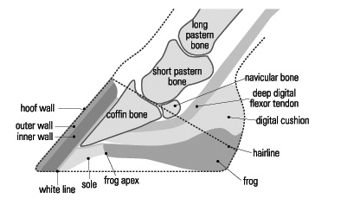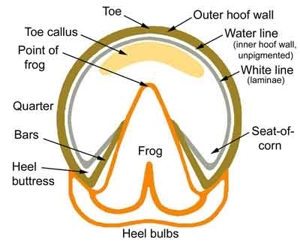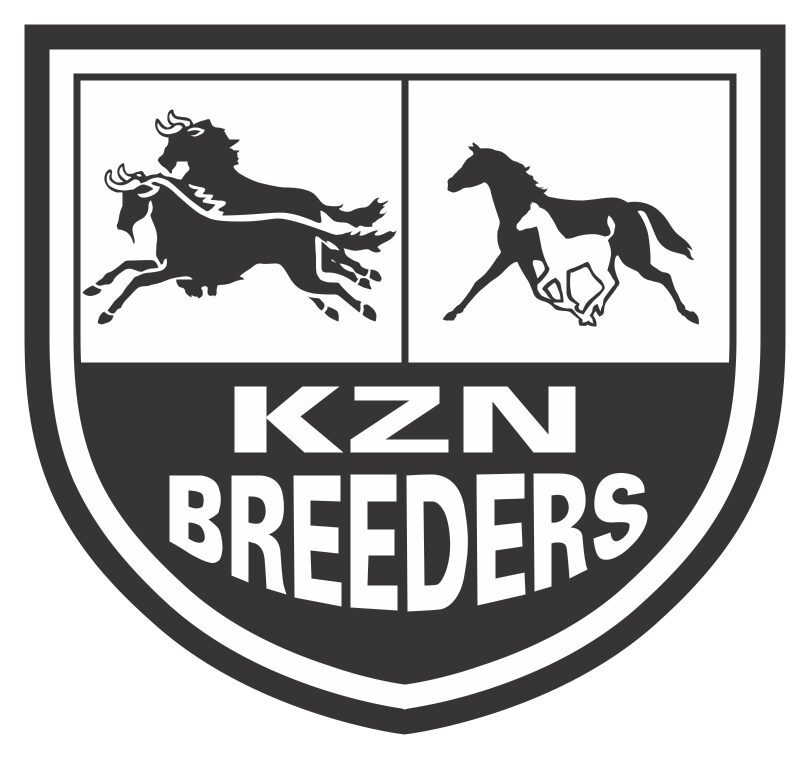Nutrition For Sound Hoof Growth
| Nutrition For Sound Hoof Growth, 03 September, 2012 – Dr Rensia Möller |

Many otherwise sound horses have been rendered hard to keep in work because their hooves are weak, dry, cracked, flaky or crumbly, soles bruise easily, collapsed heels or hoof walls cannot retain nails and therefore shoes. Horn quality is strongly affected by genetics, and it is advised to purchase sport horses of a breed noted for sound feet large enough for their body size, or descending from especially Thoroughbred bloodlines with good hoof quality. Unfortunately in Thoroughbred breeding speed, strength, power and endurance, and not feet, are the desired traits selected for.
It is however, within limits, possible to improve the quality of hoof horn growth, by feeding appropriate nutrients and with proper hoof care. A good quality total diet that contains all the key ingredients as listed below is essential, and supplements may possibly be needed to achieve this.
Understanding how the hoof grows:
The horn of the hoof wall consists of the same keratin protein from which hair is made. Keratin sulphate the structural component of the hoof wall is produced from two sources: by a special layer of cells called the coronary corium in the coronary band above the hoof and by the inner layer of laminae cells within the foot.
As the horn cells in the coronary band and laminae produce keratin, the horn expands outward from the laminae and down the coronary band toward the ground, forming a double layer of hoof wall. It takes 4-6 months for horn at the top of the hoof to grow down to the base, where shoe nails are clinched. It takes 3-4 weeks for the inner wall to grow outward to thicken the layer just inside the wall.
The best way to improve hoof horn quality is by combining in twofold:
- From the outside regular shoeing/trimming by an accomplished farrier every 4-6 weeks depending on hoof growth, &
- From the inside out proper nutrition to supply the replicating horn cells with the raw material needed for growth at the appropriate levels and growth stages.
Good quality total diet and/supplements:
Supplements with the following synergistic ingredients can be fed: biotin, methionine, zinc, iodine, calcium, magnesium, fatty acids and sulphur. Biotin, methionine, iodine and zinc have been scientifically proven to enhance growth and strength of hooves. The important ingredient in methionine is sulphur, which can be supplied in its organic form by the supplement MSM.
Biotin is a B vitamin integral to the enzyme chain that produces keratin in the cells. If biotin is insufficient, hoof growth proceeds very slowly, even if enough methionine is present. Although biotin appears in most hoof supplements, its inclusion level and efficacy in supplement form should be questioned, as well absorbed forms are very expensive and effective level is 20mg of biotin per daily serving. Believing that it improves hoof quality, the other consideration is time factor as it takes more than nine months, thus whereas in humans one waits this time period (knowing that sperm do their job!) to see whether it is a boy/girl or nowadays multiples…in the horse one waits the same time to see if the hoof growth improves?!

Good quality protein and found in soybean meal and lucerne will supply the amino acid methionine, and therefore sulphur which is the “glue” that holds the keratin strands together.
Zinc, acting as a coenzyme, is an essential component of the enzyme system that produces keratin protein. Fatty acids found in full-fat soybean meal and lecithin, in sufficient supply, not only provides much of the raw material for the hoof horn, but will also contribute to improved coat condition.
Added calcium is essential for cohesion in the hoof wall and magnesium is an essential mineral in keratin forming enzyme processes. The best approach is to feed the abovementioned nutrients in supplements containing a yeast culture that feed the beneficial gut bacteria, increases nutrient digestibility, mineral absorption and protein utilization; combined with forage-based rations including lucerne as protein, magnesium and calcium source, to promote healthy hindgut function and therefore additional bacterial secretion of biotin. Else you will have to buy more than one supplement to obtain all the nutrients and have a qualified nutritionist have the total daily diet intake evaluated to make sure dietary requirements according to work profile are met.
Proper hoof care:
Since hoof horn grows from the top of the hoof, horn that is already formed cannot be much affected by diet. Although a change in the upper hoof horn may be seen in 6 to 8 weeks, at least 16 weeks of supplementation is required to achieve benefit.
Keeping existing hoof horn sufficiently moist can however be of benefit to retain its strength and integrity. The periople, a layer of natural varnish, grows outside the hoof horn from the perioplic corium and covers the horn surface to minimize moisture loss from the hoof. This periople can be rasped away by the farrier when he trims the hoof for shoeing and rasps too far up the hoof wall.
Under hot, dry conditions a horse’s hoof loses 15% of its weight per day as moisture is lost through the sole – a protective film can help minimise this loss.
Some materials can replace the periople by acting as a varnish to impede moisture loss from the top hoof horn, such as Kohnke’s Hoof-Seal. Hoof-Seal is an innovative hoof sealant containing natural protective hoof oils and porous, breathable polyutherane, that provides a thin wear resistant film which helps minimize moisture variations within the hooves to help prevent drying out and cracks in hot weather, and excessive softening in wet weather; which allows the hoof to ‘breathe’ whilst minimising moisture variations.
All hoof dressings can however do is only help retain existing strength. Tensile strength cannot be increased beyond that which the horn started out with, and using too much dressing will weaken the bonds between the keratin strands and hence weaken the hoof wall….again proving that more is not always better, and prevention is better than cure.
Schedule regular farrier visits every 4-6 weeks to obtain informed feedback on hoof horn quality progress, and adjust diet/supplements, shoeing/trimming, hoof dressing, rest/workload and work surface, bedding and paddock surface accordingly.
Best advice: ‘no foot no horse’….as high costs will be incurred on supplements and farrier care and improvement will be based on dedicated management to achieve and maintain soundness…so rather start off and purchase a sound prospect with quality feet…and have ‘good feet, happy horse’ and enjoy your riding and performance success.
All the best
Rensia Möller

 Dr Rensia Möller Dr Rensia MöllerEquine Veterinarian and International Nutritionist Dr Rensia Möller obtained her Agricultural Science before graduating cum laude for her BScAgric Honours in Equine Nutrition and Genetics. She obtained her Masters in Equine Exercise Physiology and Equine Nutrition at the Onderstepoort Veterinary Faculty before completing her Veterinary Science degree at Onderstepoort cum laude. She opened an equine veterinary and nutrition practice in 2002, as well as developing her own equine nutritional supplement brand in South Africa. She was appointed manager of Zabeel Feedmill in Dubai in 2006 where she custom designed professional performance equine feeds for various internationally acclaimed trainers including Mike de Kock, competing for the Dubai World Cup, with numerous race winners and success stories on these feeds. She also exclusively developed formulas for the world renowned Godolphin and Darley equine racing and breeding houses. She is currently on board the dynamic Epol team, doing part-time consultancies for Epol clients, and passionately formulating and upgrading their range e.g. the newly launched long awaited mueslis and the international add-on of the Mike de Kock racing range. She is also available for private client consultancies. |

